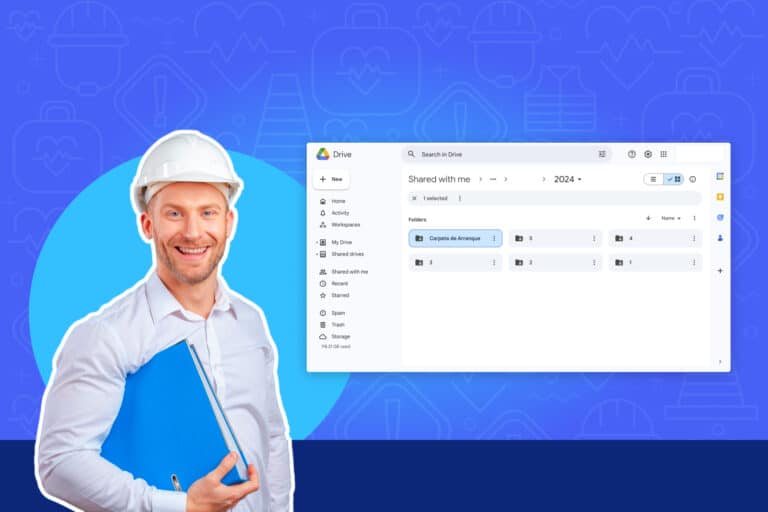The “Personal Protection Elements”, or commonly known as PPE, are fundamental links in the chain of safety and labor protection. Therefore, it is essential to have strategies and technological tools that allow us to inspect them periodically, in detail and efficiently.
By their very nature, as well as by various environmental or even geographical considerations, productive and industrial activities tend to present a high level of risk and danger for those who carry them out. This makes the permanent use of “Personal Protection Elements”, or PPE, essential to protect the safety and integrity of workers.
Technically, PPE is any equipment, apparatus or device specially designed and manufactured to protect the body from all damage or injury caused by work accidents or occupational diseases.
In this context, the law obliges the employer to provide these elements to all workers or operators who require them, depending on the work they perform and the consequent risk to which they are exposed.
Importance of PPE
Although PPE alone does not eliminate the risks and dangers present in the workplace, it does protect people and can substantially reduce the severity of injuries suffered in the event of an accident.
For example, protective elements as simple as a helmet, gloves, goggles and safety shoes can prevent from burns or lacerations to the extremities, to severe trauma and fatal injuries.
For this reason, the mandatory and regulated use of PPE must always be framed within a preventive plan that supports its implementation and also allows the provision of adequate complementary information and training tools to workers regarding their use.
It is enough to remember that in any workplace that involves moderate to extreme risk, such as a mining site, a building under construction, a forestry area, or a chemical factory, among other examples, the risks faced by the workforce are part of daily activities.
And it’s not just about protecting ourselves against falling objects, explosions, or bumps against blunt elements. There are also multiple risks associated with other situations that go more unnoticed, such as excessive ambient noise or the presence of chemical, toxic and / or polluting substances.
All these variables require that the management of each company, as well as the professionals in charge of the respective Occupational Health and Safety departments, implement an appropriate plan according to the needs of each company. This must define the pertinent PPE for the tasks that are carried out in, as well as establish a program of control and periodic inspection of the elements arranged to protect the safety of the workforce.
How to apply a proper PPE plan
First of all, we must consider that any inspection plan for Personal Protection Elements consists of a process that must be carried out in the same workplace. Only in this way will it be possible to guarantee the quality, condition and proper functioning of each of these equipment.
Likewise, inspections must be carried out by specially trained personnel for this purpose. It can be made up of external consultants, or by plant officials. The only common denominator is that they have the skills and knowledge necessary to design a plan, implement it and make it known to all workers in the company.
At the same time, they must keep it sufficiently updated to adapt to eventual changes in context, or to new dangers or risks that arise with the advancement of long-term activities.
Once the PPE inspection team has been formed, it is necessary to verify that the process is carried out according to a clear methodology. It may consider the following steps:
1. Inspect the workplace:
Identify physical risks such as, for example, exposed cables, poorly demarcated driveways, obstructed areas, chemical or flammable substances present in the environment or materials prone to detachment, among other variables.
Likewise, if the workplace is located indoors, it is necessary to ensure the good condition of other complementary protection elements, such as fire extinguishers, and identify and signal all emergency exits.
2. Check the equipment:
We should make a complete list of all safety equipment that is distributed to workers, both individually and collectively, in order to clearly identify them and, simultaneously, knowing in detail what items may be missing from the inventory.
3. Observe the workforce
Prudent time must be allocated to observe and analyze the way in which workers carry out their daily activities, as well as to be clear about what personal protection elements they actually use and, simultaneously, to know if they do it correctly to protect their safety and health.
4. Dialogue with workers
Once we made the observation and obtained the pertinent conclusions, it is necessary to talk with the workers, to clarify their doubts and identify any insecurity that they notice regarding their workplace. In this way, it will also be possible to identify the possible causes of misuse of the equipment, and to draw up the respective corrective education and awareness strategies.
Once all these steps have been taken, and after obtaining the most relevant conclusions from the observation and dialogue process with the workers, we must draw up a PPE inspection format that allow us identifying those elements that are in good or bad condition.
In this way, it will be possible to set a standard of action that will allow optimizing the strategies for the protection and care of the workforce of the entire company.
To achieve the greatest possible clarity in this phase of the process it is necessary to adopt a precise categorization. At this point, occupational safety experts recommend acting according to three objective parameters:
- Good (B): All equipment that is in optimal condition, both from a functional and structural point of view, must be classified as “Good” to provide the protection and security required by the user.
- Regular (R): All equipment that only has some of the functionality and status characteristics required to provide optimal protection should be classified as “Regular”. If this condition is not met, the personnel in charge of the inspection should recommend that it is not safe to use this element, and request a replacement as soon as possible.
- Bad (M): All PPE that does not meet any of the characteristics and specifications required to provide protection and safety to the worker must be classified as “Bad”. In these circumstances, the personnel in charge should remove it immediately, and replace it with equipment in good condition.
The value of digital tools
For this PPE inspection form to be efficient, we should also consider a checklist of the status of each personal protection item to be inspected. Two specific variables designated as “Use” (U) and “Condition” (C) must be recorded in this list, which are valid for each of the elements used by all workers, such as helmet, goggles, hearing aids, safety masks. oxygen, protective suits or safety shoes, among others.
However, the success of this strategy is not only based on the level of detail that the inspection achieves, but also on the ability of the team in charge to apply it consistently and efficiently.
For this, it is essential to put aside mechanized systems based on paper forms, which are often unfriendly, poorly sustainable and highly prone to human error.
In this sense, digital technology offers new and powerful tools and applications that allow the creation of electronic checklists capable of being permanently updated, and having a more direct, exhaustive and precise control of all the variables previously analyzed.
Only in this way will it be possible to guarantee both the good condition of the Personal Protective Equipment, as well as the adequate implementation of an inspection plan and its use. Both conditions are essential for any company or organization that aspires to take care of its Human Capital, and strengthen its competitiveness in the market.
In addition, it will contribute decisively to a better sustainability and circularity policy, since the use of large amounts of paper will be significantly reduced, which would otherwise end up increasing the company’s pollution cycle. Besides the negative environmental impact in terms of misuse of natural resources and increased carbon footprint.
Download the DataScope app and start now!
DataScope is the ideal tool to eliminate paper use, save time, and efficiently collect data from the field. It allows companies to streamline, organize and evaluate field work thanks to its online forms, which provide indicators in real time, 100% adaptable to any area.
With DataScope, your team can answer custom mobile forms from their phones or tablets, online or offline, through the app.







